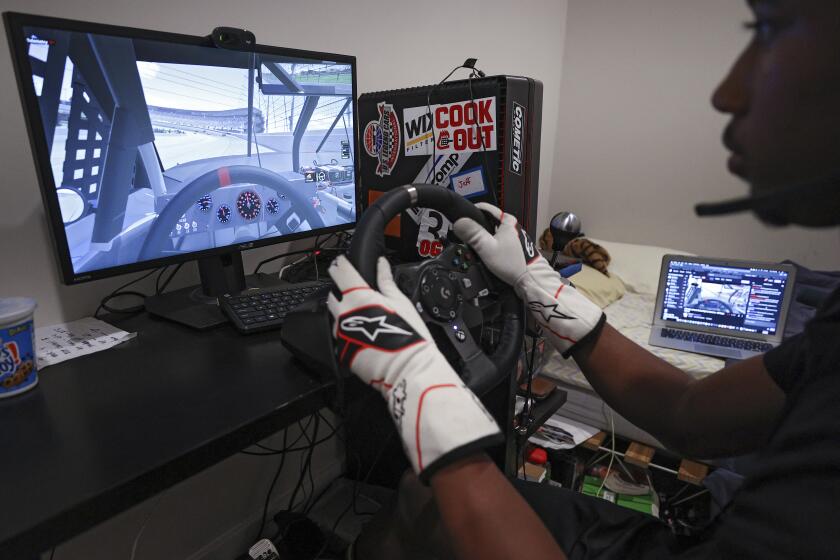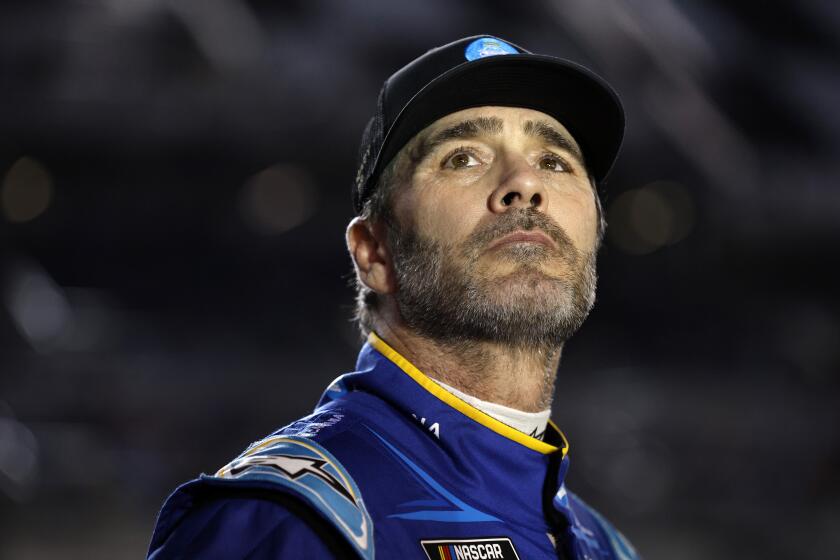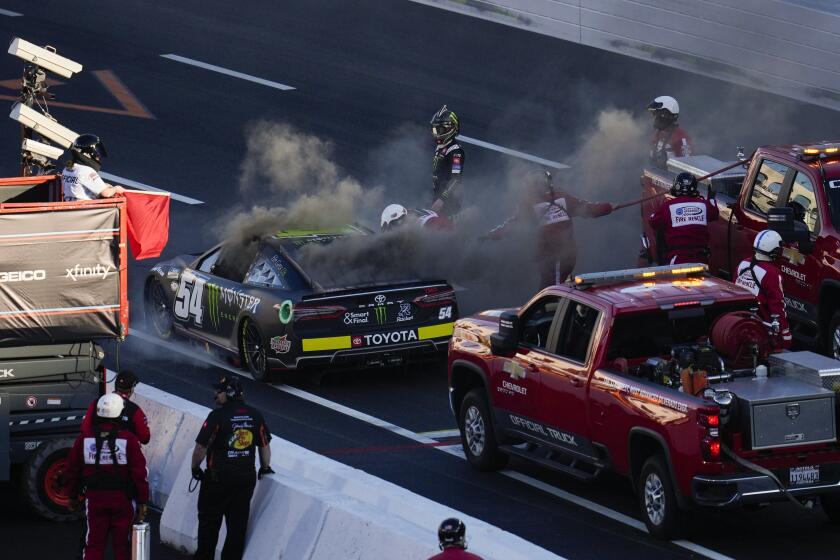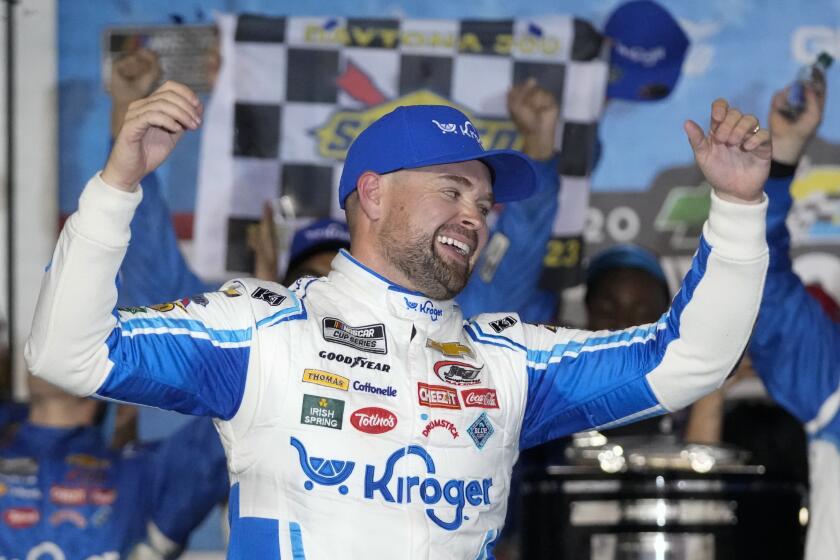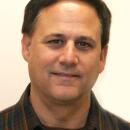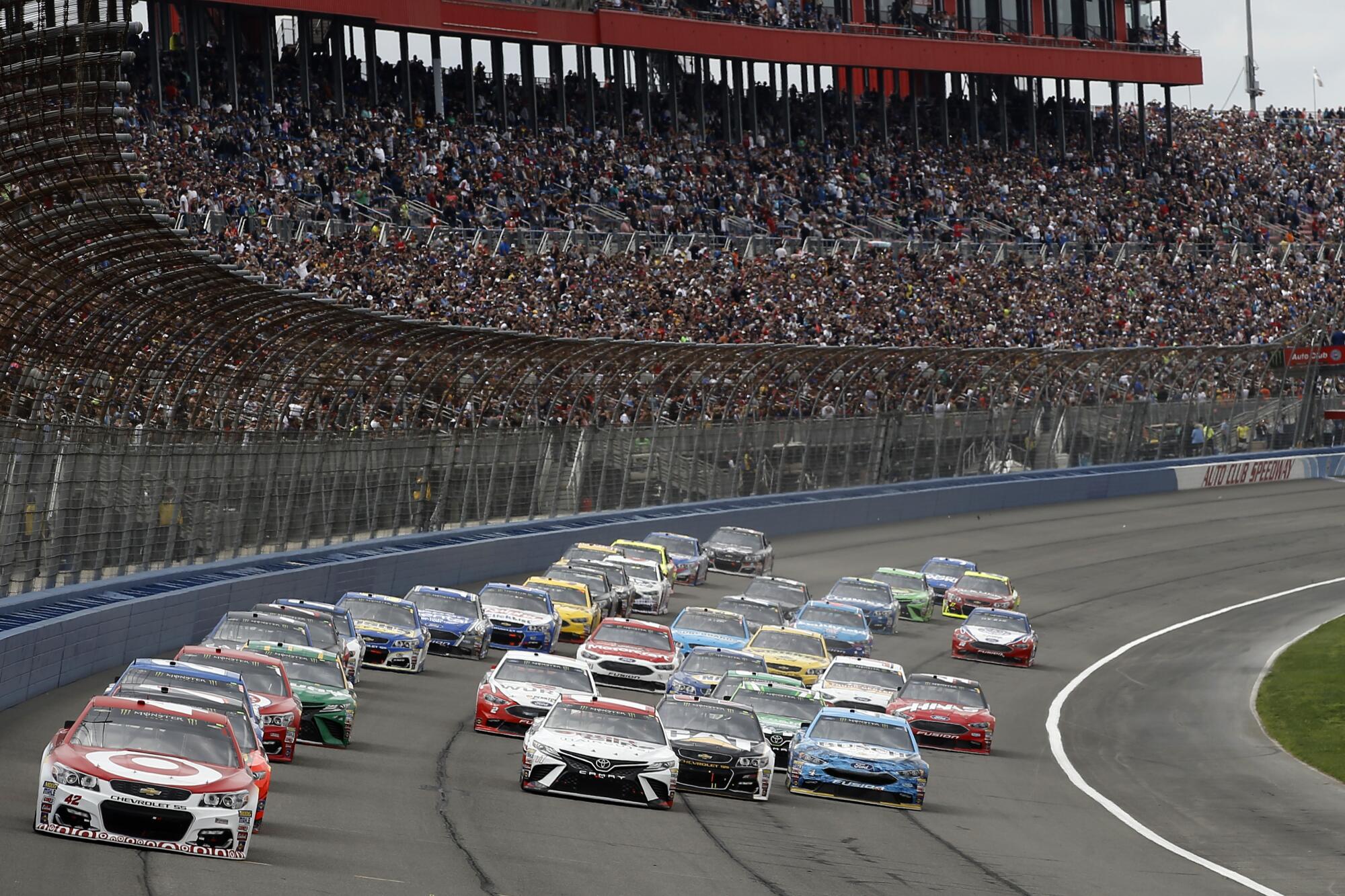
Long before Jimmie Johnson and Kyle Busch notched their first NASCAR Cup Series victories at legendary Auto Club Speedway, Fontana was home to a quarter-mile strip that became a major stop for the National Hot Rod Assn. while also attracting on a nightly basis all manner of amateur racers.
Oh, and a monster.
Not a monster truck or an energy drink, but an alleged beast described by a local newspaper as âa horrible monster with a hairy body, long hands, and claws dripping with slime.â
Two teenage girls reported to the San Bernardino County sheriffâs office in August 1966 that while parked on Base Line Road near the racetrack, the creature emerged from behind a bush and scratched the neck of Jerri Lou Mendenhall, 16, before she made like drag racer Bill âGrumpyâ Jenkins, hit the accelerator and sped away.
Rajah Caruth didnât step into a race car until 2019 but even before his first lap Mike Beam, the man who owns that car, knew he would be a great driver.
Sheriffâs deputy O.W. Manning said, âI think this monster business is a lot of hooey,â but hysteria ensued anyway, with teens descending on the area with .22 rifles. The monster apparently eluded them because for years spectators at the popular dragstrip reported sightings in the brush beyond the track.
The creature, rather inelegantly named âThe Invincible Brush Manâ by the Ontario Daily Report, seemed oddly drawn to noisy racetracks. So when the nearby Auto Club Speedway begins its long-awaited and extensive remodeling after Sundayâs Pala Casino 400, perhaps workers can be on the lookout for its remains. Or at least an enormous three-toed footprint.
The plan is to reduce the track from two miles to a half-mile and modernize the speedway so that races appeal to a broad demographic, not just hardcore NASCAR fans. Details are scarce so far â and itâs possible NASCAR could abandon the project â but a remodeled speedway should fit neatly into NASCARâs current strategy of making attending a race more than simply attending a race.
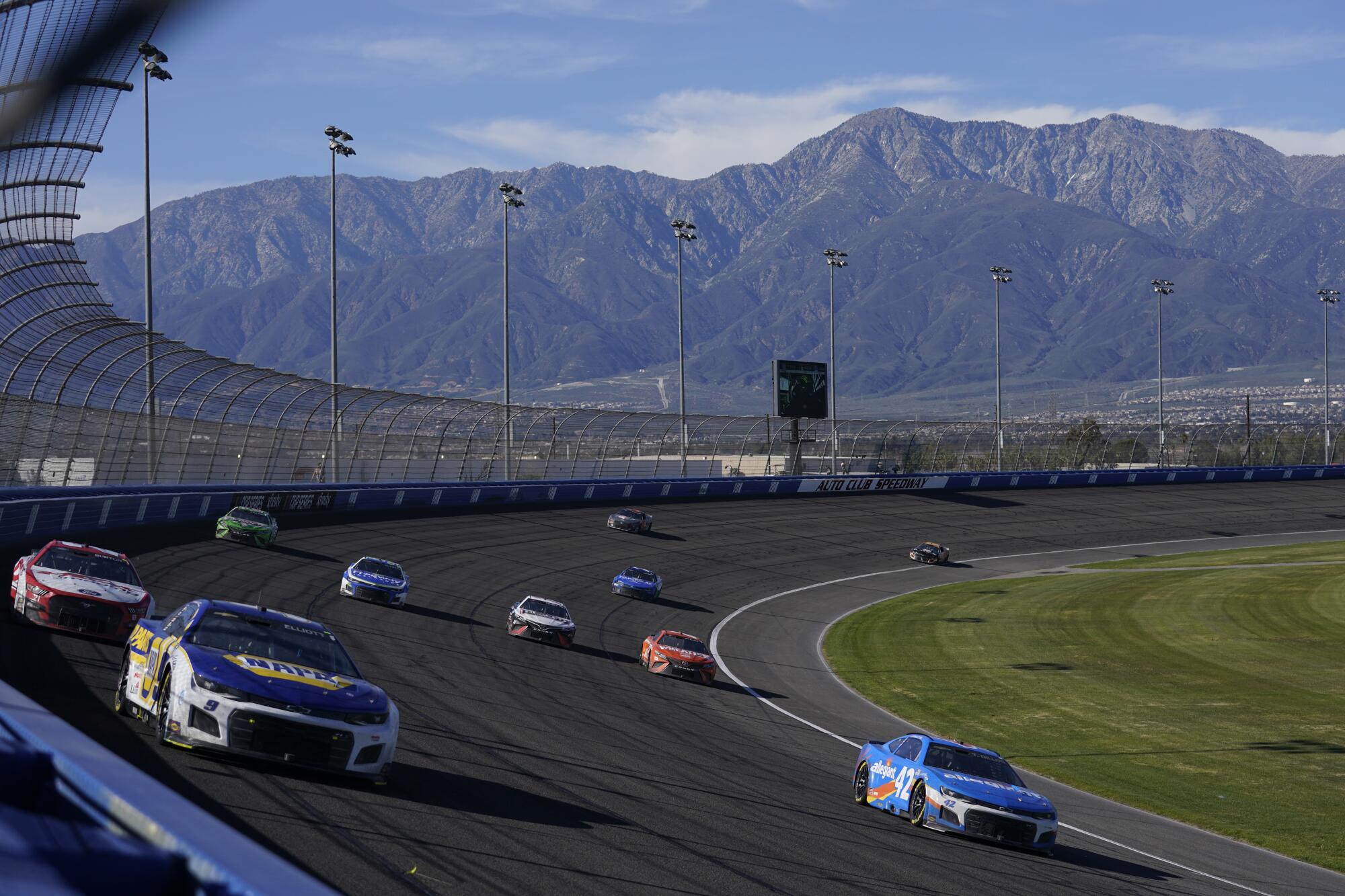
âI think weâve been at a point where entertainment is our business,â Auto Club Speedway president Dave Allen said. âWhat the drivers do on the track is how memories are generated and what people are thinking about when they leave. But itâs the integration of everything. Itâs important for us to stay diversified and provide entertainment for people to have fun all day long.â
Last monthâs Clash at the Coliseum and this summerâs Chicago Street Race provide the template. Expect the new Auto Club Speedway â which is expected to take up to two years to rebuild â to have improved dining options and more comfortable seating. It will serve as a concert venue and host a variety of other events.
And it likely will include a nod to the rich history of motor sports throughout the Southland, and the Inland Empire in particular.
âThe fact that we are in such a hotbed of motor sports history is something I want to scream from the top of a mountain,â Allen said. âAs we talk about the new design, we can include areas that tell the story of how we got here.â
Cup and Xfinity to race back-to-back
The NASCAR Xfinity Series race scheduled for Saturday was rescheduled due to inclement weather until Sunday at 5 p.m. The Production Alliance Group 300 will follow the Cup Seriesâ Pala Casino 400, which will begin at 12:30 p.m.
Practice and qualifying for the Pala Casino 400 was canceled Saturday. Christopher Bell was awarded pole position for the race and Ricky Stenhouse Jr. will join him on the front row. The starting lineup was set by performance metrics based on last weekâs Daytona 500.
A ticket to the Pala Casino 400 is good for both races. Production Alliance Group 300 ticket holders will be admitted following the conclusion of the Cup Series race. Parking lots open at 5 a.m. and gates open at 7 a.m.
Tickets can be purchased at www.autoclubspeedway.com. Monitor @autoclubspdwy on Twitter for the latest information.
Inland Empire cautionary tales
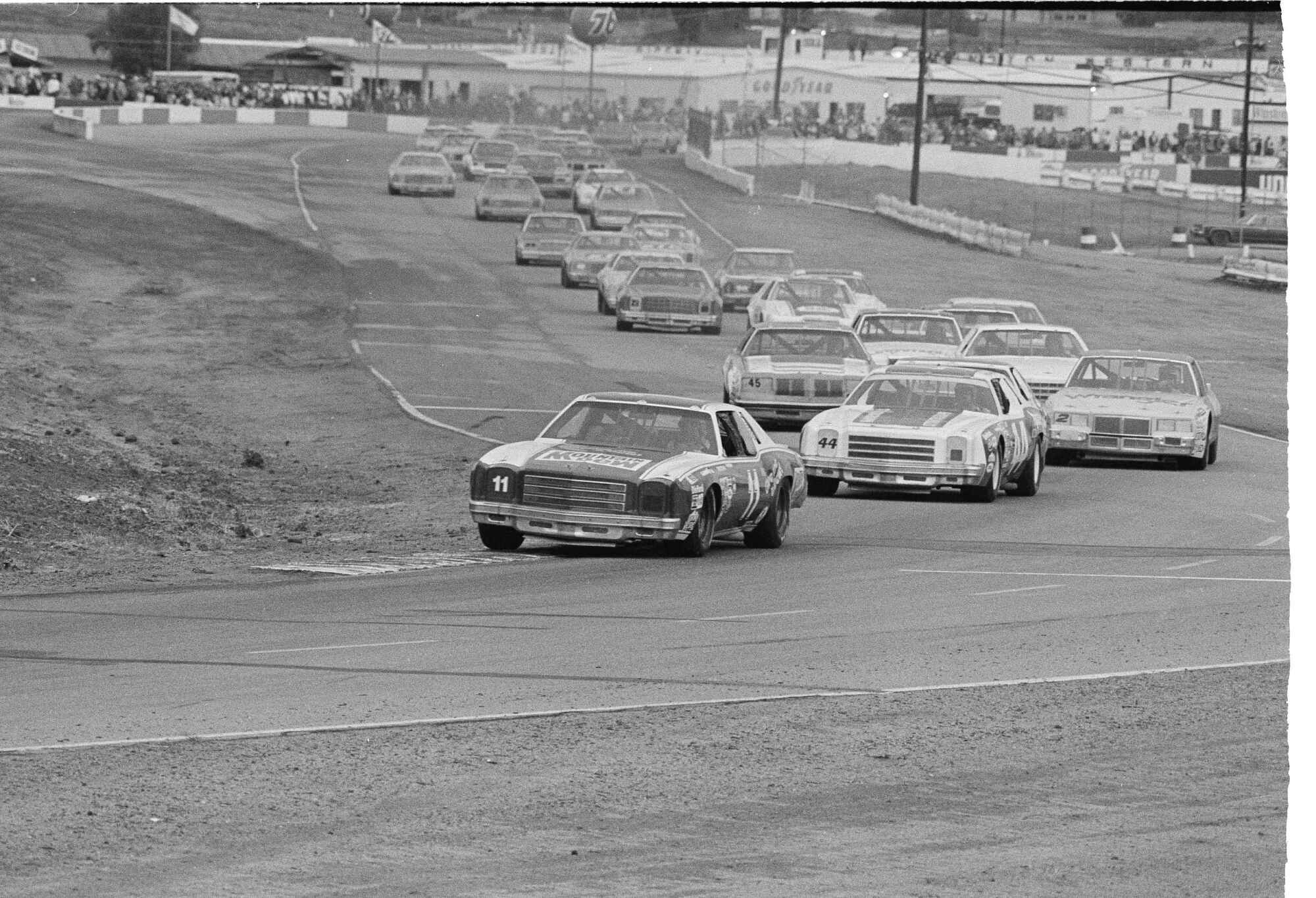
Predecessors can offer more than nostalgia. Not far from the Auto Club Speedway were two initially popular racetracks whose demise remind NASCAR to keep Fontana relevant to a young, technologically savvy audience.
NASCAR confirmed Friday that it has closed a deal to sell a large part of the Auto Club Speedway land to its business partner Hillwood, a Dallas-based company that is helping NASCAR sell parts of its extensive properties nationwide. NASCAR will retain 89 acres and says it will continue with plans to develop the half-mile track.
The sale has long been part of the strategy to downsize the current configuration, according to a NASCAR official who requested anonymity because heâs not authorized to talk about the topic on the record. Proceeds from the sale could be reinvested into the new track.
For race fans, that plan is infinitely preferable to what became of once-robust raceways in Riverside and Ontario.
For 32 years, Riverside International Raceway was considered a cutting-edge venue because of its ability to stage Indianapolis 500-style racing, NASCARâs Winston Western 500, dragsters and motorcycles on three track configurations of different lengths.
The Times sponsored a Grand Prix at the raceway every year and movies such as âThe Love Bugâ and TV shows including âThe Rockford Filesâ and âCHiPsâ were shot there.
No matter. Attendance dwindled, the suburb of Moreno Valley grew around it and new neighbors complained about the noise. The land became too valuable for the racewayâs owners to resist selling in 1989, and now a mall sits where cars roared.
For a seeming eye blink, three miles from the Auto Club Speedway lived another track that opened to great expectations. The Ontario Motor Speedway, billed as the âIndianapolis of the West,â was demolished 10 years after it was built in 1970.
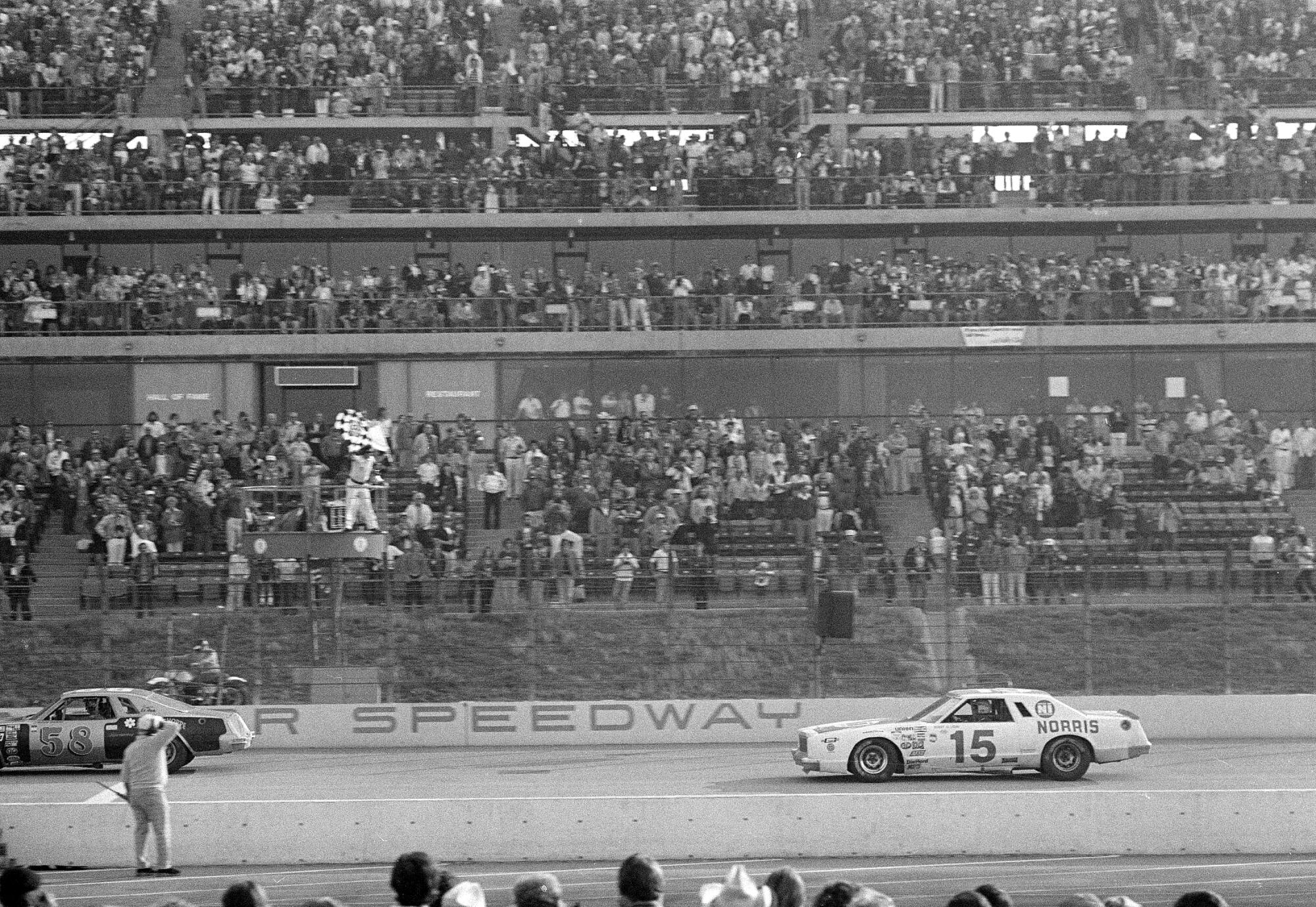
Not that it lacked certain charms. It was the first venue to provide corporate suites and offer memberships to a private stadium club. Paul Newman and Kirk Douglas sat on the board of directors. The trackâs first race was a celebrity pro-am featuring entertainment industry hotshots paired with professional drivers, and it aired as a TV special.
The 2.5-mile track was built as a replica of the Indianapolis Motor Speedway, complete with a rectangular oval configuration and low banking in the turns. Garage facilities were first-rate. Retaining walls were considered the safest ever built. And a computerized timing and scoring system was so popular it was adopted by the Formula One circuit.
The venue was utilized for more than racing. Evel Knievelâs record jump over 19 cars drew 50,000 a day before the Miller High Life 500 in 1971. Two enormous rock festivals, California Jam in 1974 and California Jam II in 1978, each drew crowds of 300,000.
Yet not even a shoot location for an episode of âCharlieâs Angelsâ could save it. The Chevron Land Company acquired the speedway and in 1980 foreclosed on the property, which these days is home to the Toyota Arena, a Hilton, business offices and condos.
California Speedway memories
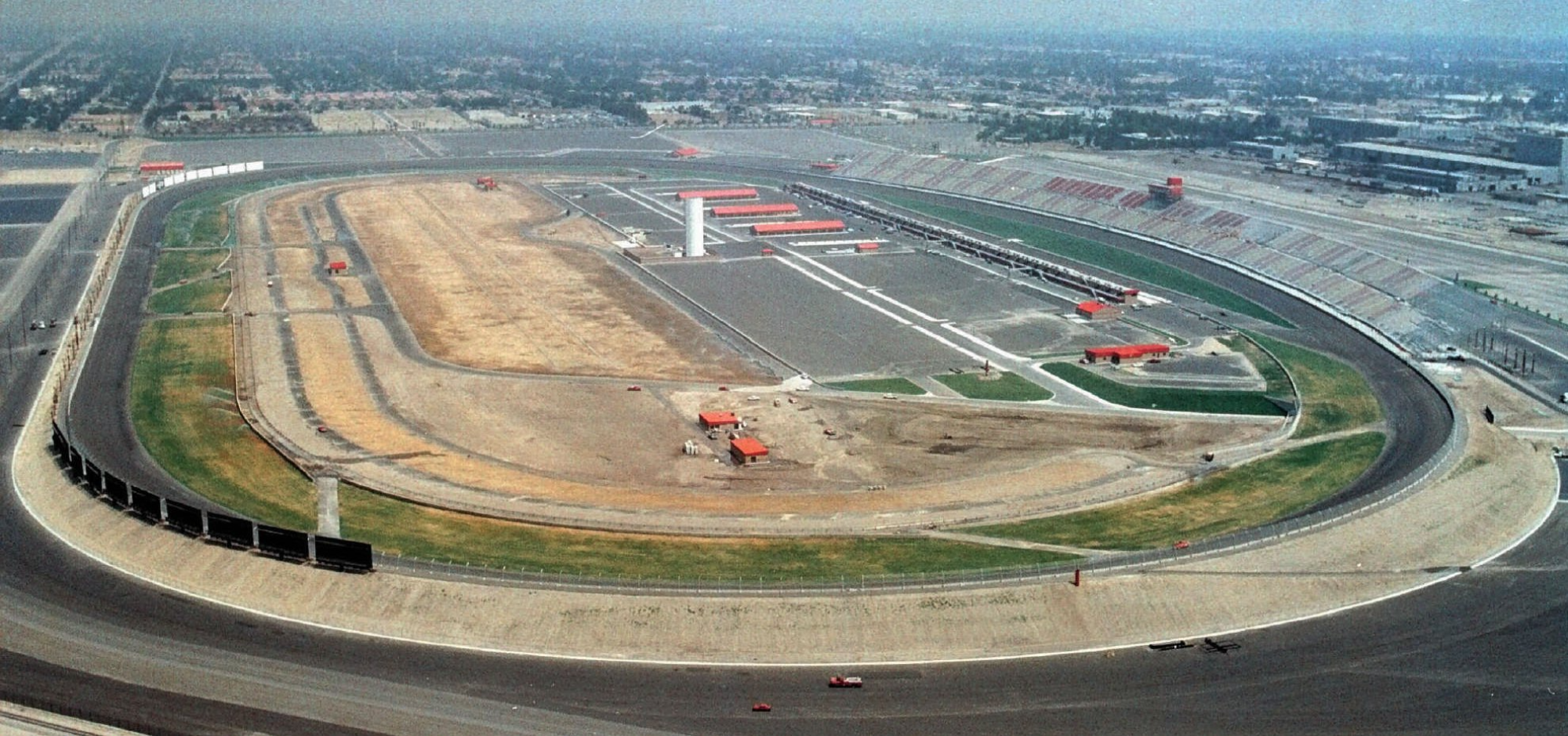
Seventeen years after the Ontario Motor Speedway vanished, Roger Penske spent $110 million to mimic his D-shaped oval at Michigan Speedway, the only other two-mile track on the NASCAR circuit. The venue was called the California Speedway until 2008 when Auto Club purchased naming rights.
Land for the speedway was purchased from the Kaiser Steel Mill, which went out of business after its World War II heyday of producing steel for airplane and ship-building plants.
Jeff Gordon won the first NASCAR race at the speedway, the California 500, by a few drops of gas. He didnât run out until his victory lap while Mark Martinâs tank emptied on the last lap and he watched helplessly as Gordon and seven other drivers passed him.
Only two drivers have posted their first NASCAR Cup Series victories at the California Speedway, and both are legends: Jimmie Johnson won in 2002 at age 26 and Kyle Busch in 2005 at 20.
Johnson grew up in El Cajon and had family and friends in the stands. He visited his hometown ahead of the race and partied afterward with Gordon, who as co-owner of Hendrick Motorsports had elevated Johnson from the Xfinity Series.
Jimmie Johnson is competing in the Daytona 500 as both a driver and owner after a two-year absence from NASCAR. Hereâs why he decided to come back.
âWe stopped through San Diego, saw some people and hit my favorite taco stand before I went up to the race,â Johnson said in 2011. âAnd having that pressure of your first win, your home track and not throw it away was all riding on my shoulders.â
Gordon suggested they celebrate by filling the motor home heâd rented with friends and heading up I-10 to L.A. for nightlife.
âWe were definitely out of place, but we had a big time,â said Johnson, who has won the Auto Club 400 a record six times.
Busch has won the Auto Club 400 four times, most recently in 2019 when he notched his 200th NASCAR victory. He was the youngest driver to win a Cup Series race when he took the checkered flag during Labor Day Weekend in 2005 at 20 years, 4 months and 2 days, a record since broken by Joey Logano.
âIt was really cool to be able to do my first burnout and celebrate with all the flashbulbs and lights and the speedwayâs fireworks,â Busch said.
The fastest time on the track is a world closed-course record set by IndyCar driver Gil de Ferran in 2000 with a qualifying lap of 241.428 mph. A year earlier, IndyCar great Greg Moore lost his life in an accident on the 10th lap of the Marlboro 500 at California Speedway.
The emergency care Damar Hamlin received was a byproduct of extensive emergency planning. In motorsports, medical personnel train for such situations.
Saying goodbye to a well-worn track
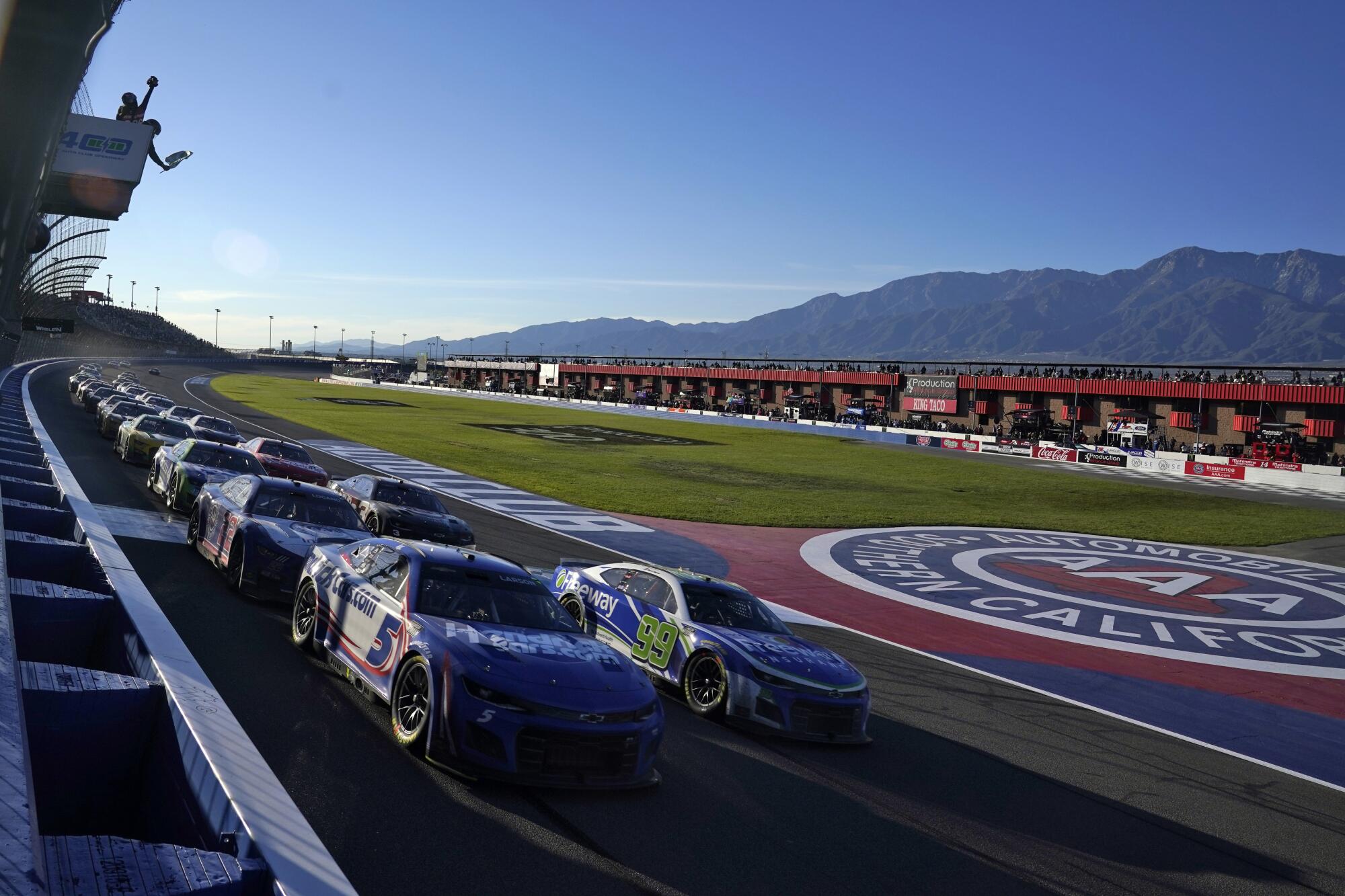
Drivers seem in lockstep when it comes to their opinions about NASCARâs decision to shorten the Auto Club Speedway track: They understand the appeal of short-track racing to fans and agree with the strategy to combine racing with other entertainment.
However, they are sad that they will run their last race on the two-mile track Sunday. Why? The track itself is so much fun.
âThere are a lot of different lane options, so we arenât all committed to the same lane,â said Kyle Larson, who won the Auto Club 400 last year and in 2017. âItâs an old worn-out surface. It makes things a handful in the cockpit, but itâs a lot of fun.â
AJ Allmendinger, the only active driver to compete in NASCAR and IndyCar races at the track, said he nearly threw up driving the Auto Club track on a simulator.
âI realized I canât eat lunch before the race because it was moving my insides around itâs so bumpy down the back straightaway,â Allmendinger said. âAs the track has aged, the racing got super good. As drivers, we all love it because it wears the tires out, you are slipping and sliding around, itâs got multiple grooves, you are running on the apron. It just puts on great racing. All of us have thoroughly enjoyed it.â
Ricky Stenhouse Jr. won the Daytona 500 in double overtime and under caution Sunday in the longest running of âThe Great American Race.â
More to Read
Go beyond the scoreboard
Get the latest on L.A.'s teams in the daily Sports Report newsletter.
You may occasionally receive promotional content from the Los Angeles Times.
